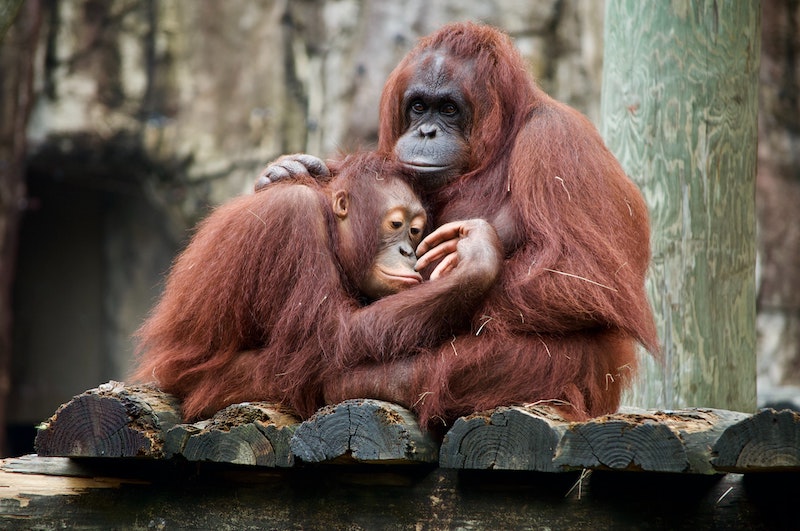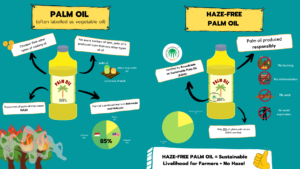Published 29 August 2022 ● Last Updated on 30 August 2022

This article has been penned by Atikah Kasim, the Outreach & Engagement Manager for People’s Movement to Stop Haze (PM Haze) – a non-profit focusing on the transboundary haze which occurs as a result of unsustainable deforestation. Her work mainly revolves around engagement with local organisations and food businesses, managing resources, manpower and volunteers, and ensuring that everything goes as planned. Atikah enjoys planning and executing events, and is passionate about contributing to building healthy, inclusive and sustainable communities.
When you hear the word ‘orangutan’, more often than not, your mind would transport you to an imagery of the forest with the primate swinging from branches to branches. Orangutan is derived from the Malay words ‘orang’ (refers to ‘people/person’) and ‘hutan’ (refers to ‘forest’). This means that orangutan is translated to being “people of the forest”, or a “person of the forest”. As their name suggests, they are native to forests and this article will help the reader understand the importance of conserving these forests. Wild orangutans can live for up to 45 years, while an orangutan in captivity can live for up to 60 years. They happen to be one of the closest human relatives in the animal kingdom too! (SaveTheOrangutan, 2022).
First up, a 101 on these beautiful creatures
– How many species are there?
There are 3 species of orangutans, the Sumatran orangutan, the Bornean orangutan and the Tapanuli orangutan (discovered in 2017). All these species differ in appearance and behaviour. Both Bornean and Sumatran orangutans have shaggy reddish fur, but the Sumatran orangutans have longer facial hair and are reported to have closer social bonds than their Bornean cousins (WWF, 2022b). While all 3 species of the orangutans are critically endangered, the Tapanuli orangutan is the most endangered, with a population of only 800, in comparison to between 55,000 and 65,000 Sumatran and Bornean orangutans left in the wild (DePalma, 2020).
-What is their natural habitat?
Orangutans generally live in the rainforest, usually in low-lying peat forests and in rainforests in Borneo and Sumatra (SaveTheOrangutan, 2022). Unfortunately, over 60% of their natural habitats in both Indonesia and Malaysia have been destroyed over the last 4 decades.
-So, what do they eat?
The diet of orangutans comprise mainly of fruits. They also eat more than 400 varieties of plants. As animals that mainly eat fruits, they play a vital ecological role as seed dispersers in their environment, which also affects forest regeneration and plant-species diversity (Seaworld, 2022).
Key threats to the orangutan species
According to International Union for Conservation of Nature (IUCN) Red List, orangutans are categorised under “critically endangered” (IUCN, 2022). Due to their categorisation, it is crucial to be aware of the threats that these primates face. According to SOCP (2022), the main ones are,
– Habitat clearing and fragmentation
Habitat clearing poses a significant threat to the orangutan population. According to SOCP (2022), between 1950-2013, almost half of Indonesia’s forests were cleared, reducing overall forest cover in the country from 162 million to 82 million hectares. In Sumatra alone forest cover was reduced by 55% between 1985 and 2014. Forests are cleared through various methods, such as slash-and-burn techniques, illegal logging, and by damage of adjacent areas. The clearing is more often than not for palm oil and paper and pulp plantations. Habitat fragmentation is another threat, in which cutting a road through a forest could drastically reduce the orangutan population by half.
– Starvation
Due to loss of their natural habitat and the food sources within as explained above, some orangutans perish due to malnutrition and eventual starvation.
– Hunting
In some cases, orangutans end up getting deliberately killed by farmers or plantation workers as they attempt to clear the forests.
– Illegal pet trade
It is illegal to kill, capture, keep or trade the primates. But this illegal act still occurs and end up being on of the reason for the depletion of the wild orangutan population.
Solutions to maintain orangutan’s natural habitats
There is hope! You can vote with your wallet and join in the conservation efforts with PM Haze in one (or all) of the three ways listed below
1. Support sustainable palm oil
Palm oil is a vegetable oil that is derived from the fruit of palm trees. Indonesia and Malaysia make up over 85% of global supply, but there are 42 other countries that also produce palm oil (WWF, 2022a). Not only is palm oil found in food items, it can also be found in household products, cosmetics, and is also used in biofuel! It is imperative to know that palm oil is a land-efficient oil crop and boycotting it is not the solution. Instead the goal should be to make the usage of ‘sustainable palm oil’ a norm. Live in Singapore? Use the supermarket guide by PM Haze– which includes products commonly found in local supermarkets that are certified sustainable.

2. Encourage your favourite restaurant to join to “Haze-Free Foodstand” campaign
Palm oil is used in 90% of eateries in Singapore and is the most efficient oil crop in the world. Very few eateries use certified palm oil that is cultivated using sustainable farming methods that preserve the environment (and can say with certainty that they do not contribute to the haze). Haze-Free Foodstand is a campaign by PM Haze that promotes the use of sustainable, or ‘haze-free’ palm oil among local businesses. There are over 30 food businesses under this campaign currently. Help by encouraging your favourite restaurant to join this campaign!
3. Peatland conservancy
Peatland conservancy is another way to conserve the natural habitat of orangutans. Peatlands in their natural state are called peat swamp forests. They cover 3% of the Earth’s surface but they store 3 times more carbon than all the vegetation in the world. A lot of our peat swamp forests will continue to degrade if we do not protect them. Restoration of burnt peatland reduced the chances of reoccurrence of fires, which in turn aids in protecting the natural habitats. PM Haze’s Peatland Restoration Programme in Sungai Tohor encourages capacity building within the community, which then leads to positive ecological and community impacts. Interested to help out in peatland conservancy efforts by PM Haze? Donate to their Peatland Restoration Programme.
Other conservancy efforts found around the region targeted specifically towards saving the orangutans and their homes
There are various conservancy efforts and organisations found within and outside the region targeted specifically towards saving the orangutans and their homes. To name some: the Sumatran Orangutan Conservation Programme (SOCP) that works on all aspects of conservation of the critically endangered Sumatran and Tapanuli orangutan; Gunung Palung Orangutan Conservation Program that focuses on scientific research and community-based conservation, and WWF Indonesia which partnered with Amazon Web Services (AWS) to better understand the size and health of orangutan populations in their native habitat. Global Forest Watch is a website that focuses on forest monitoring and tracks hotspots.
“Make things easy for people and do not make them difficult, and cheer people up and do not drive them away.” [Prophet Muhammad]
On that note, sustainability and community goes hand in hand. Going green requires a collective effort from the community, in addition to individual actions. When we work together and support green practices, we are supporting the protection of natural habitats.
References:
DePalma, E. (2020). How Many Orangutans Are Left. Retrieved from https://www.orangutan.com/how-many-orangutans-are-left/
IUCN. (2022). Orangutans. Retrieved from https://www.iucnredlist.org/search?query=orangutan&searchType=species
SaveTheOrangutan. (2022). Orangutan Facts. Retrieved from https://savetheorangutan.org/about-the-orangutan/
Seaworld. (2022). Orangutans: Diet & Eating Habits. Retrieved from https://seaworld.org/animals/all-about/orangutans/diet/
SOCP. (2022). Retrieved from https://www.sumatranorangutan.org/sumatran-orangutans/threats/
WWF. (2022a). 8 Things To Know About Palm Oil. Retrieved from https://www.wwf.org.uk/updates/8-things-know-about-palm-oil
WWF. (2022b). Orangutan Facts. Retrieved from https://www.worldwildlife.org/species/orangutan



0 Comments